Porsche's greatest Le Mans moments
As Le Mans success stories go, the 956/962’s is unusually long, stretching for 12 years. With input from designer Norbert Singer, Gary Watkins looks back at the moments that made the legend
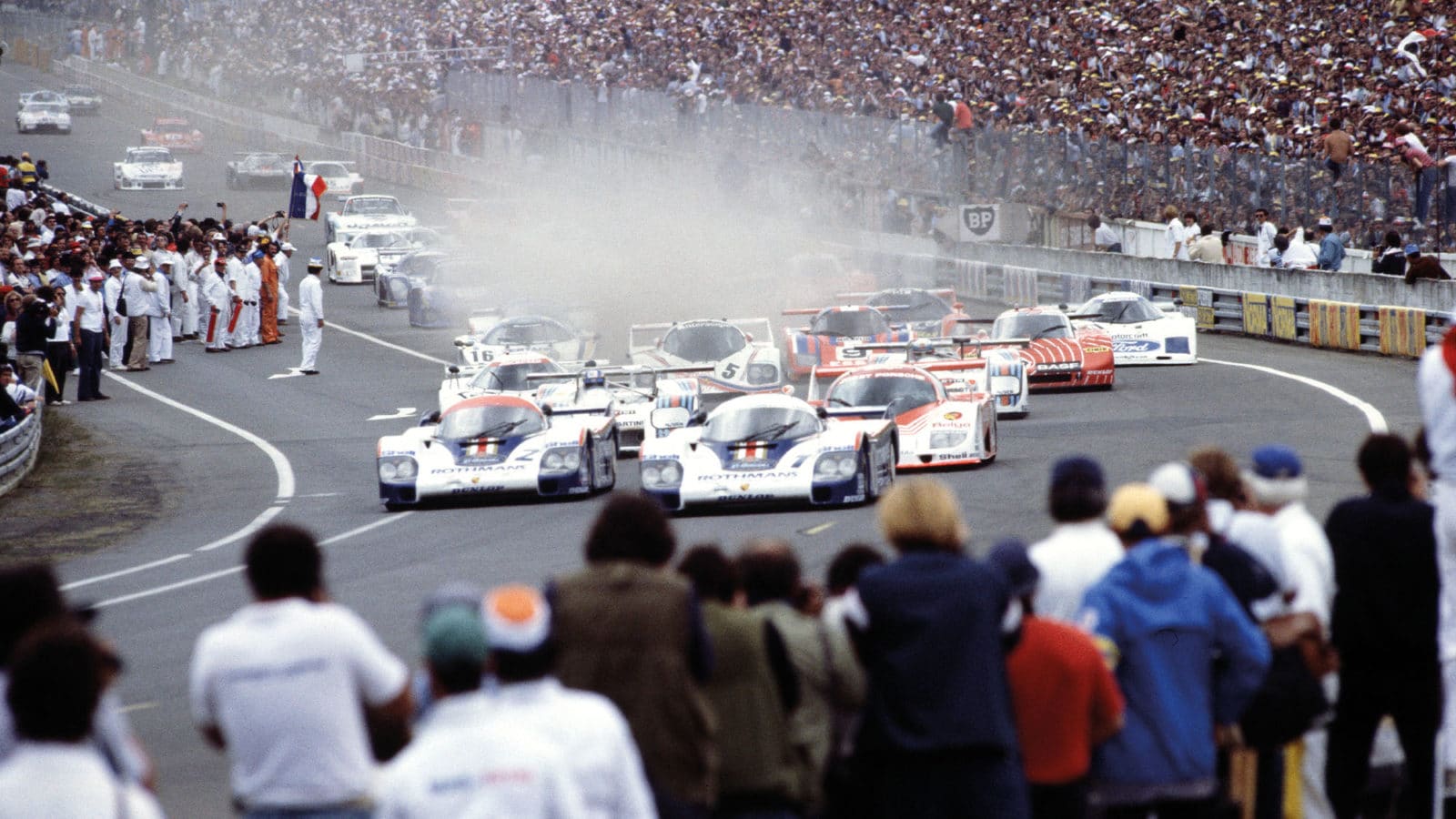
ACO and IMSA are hoping for privateer-packed field similar to sports cars' '80s heyday
Klemantaski Collection/Getty Images
1982 Le Mans 24 Hours
Porsche win didn’t come as easy as 1-2-3
Porsche laid down a marker with the 956 on its Le Mans 24 Hours debut in 1982. The in-house factory team’s trio of Rothmans-sponsored cars notched up a 1-2-3 in a portent of what was to come for the new Group C design. Yet it wasn’t as easy as it looked.
The 956 project had only been given the go-ahead at the beginning of the previous July — the start of the financial year at Porsche — and the design arrived at Le Mans with only one race and no endurance simulation under its belt. That was significant for a car that broke new ground for Porsche. It was the manufacturer’s first design built around a monocoque chassis and the prototype incorporated another first in ground-effect aerodynamics, yet it didn’t turn a wheel for the first time until the end of March.
“There just wasn’t time for endurance testing,” recalls Norbert Singer, who headed up the design of the car. “We did our first test at Paul Ricard, raced at Silverstone, and then had to build up our three cars for Le Mans. We were sure the engine could do it because it had won the race the year before [in the 936], but the gearbox was new along with almost everything else. I was asked before the race how I felt and what our strategy was going to be. I said, ‘Let’s get to 12 hours and then 18 hours, and see if we are still running.’”

Norbert Singer at Le Mans in 1974 offers advice to Helmuth Koinigg and Manfred Schurti
All three 956s were still running, though they had endured issues, when the clock ticked past the 18-hour mark in first, second and third positions. A late problem for the only rival within striking distance of the Porsche train meant there was nothing to stop the new car blocking out the podium.
“We finished 1-2-3, which was a great achievement,” says Singer. “We hadn’t done a 24-hour test, so seeing the three cars cross the line together was a big moment.”
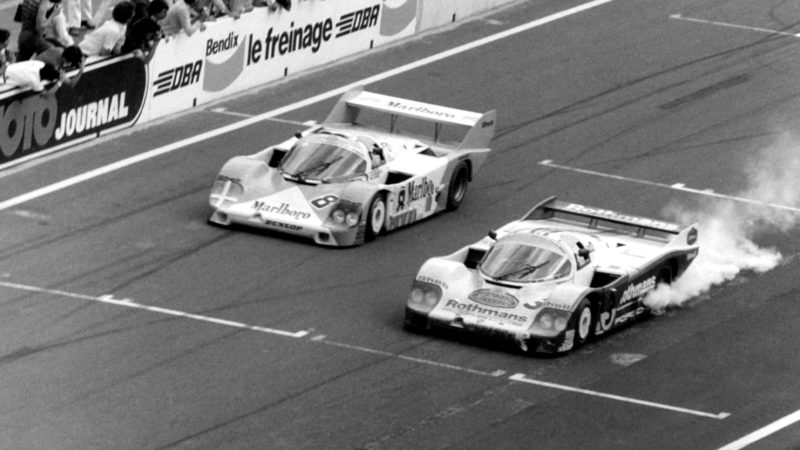
It was a 1-2-3-4-5-6-7-8 for the 956 in ’83, but it was no easy ride for the eventual winner, right, which suffered overheating problems
Getty Images
1983 Le Mans 24 Hours
High drama right to the line
Finishes don’t come much more exciting than this. Two factory Porsches, both ailing, raced to the line in 1983 to claim a 1-2. Just. The engine in the winning 956 wouldn’t have managed another lap after claiming a narrow victory over a car that needed a change of front brake discs and was on its last dregs of fuel.
The winning car driven by Al Holbert, Vern Schuppan and Hurley Haywood looked home and dry in the closing hours. The other factory car shared by Jacky Ickx and Derek Bell had endured a difficult race from the moment the former was punted off on the opening lap.
The complexion of the race changed when an incorrectly closed door was ripped off when Schuppan tried to shut it at speed.
A replacement was prepared in the pits and then the fix to keep it in place played havoc with the car’s cooling. “The air duct to the water radiator is in the door,” explains Singer, “so when the door is not properly fixed the airflow is spoiled and the engine started overheating.”
Holbert was tasked with nursing the car home. In the Ford Chicane he felt the engine seize and instinctively banged the car into first gear and stood on the throttle. Miraculously the engine freed and he set out for one last lap.
Bell was in pursuit after moving back onto the lead lap with 15 or so minutes to go. The car had cracked front brake disks, which team-mate Ickx had insisted needed changing. Bell, who took over for the run to the flag, successfully argued that they should push on in pursuit of a last-gasp victory with what they had.
“We were told never go use the transmission to slow the car, but over those last laps I beat the crap out of the gearbox,” recalls Bell, who was able to lap only a couple or so seconds off Ickx’s fastest lap. “I don’t remember the brakes getting any worse and I seemed to get quicker.”
Bell’s charge was to no avail. Holbert crossed the line to take victory by an official margin of 65sec, though Bell insists it was closer than that. His stepfather, sitting in the stands opposite the pits, had it at less than half that.
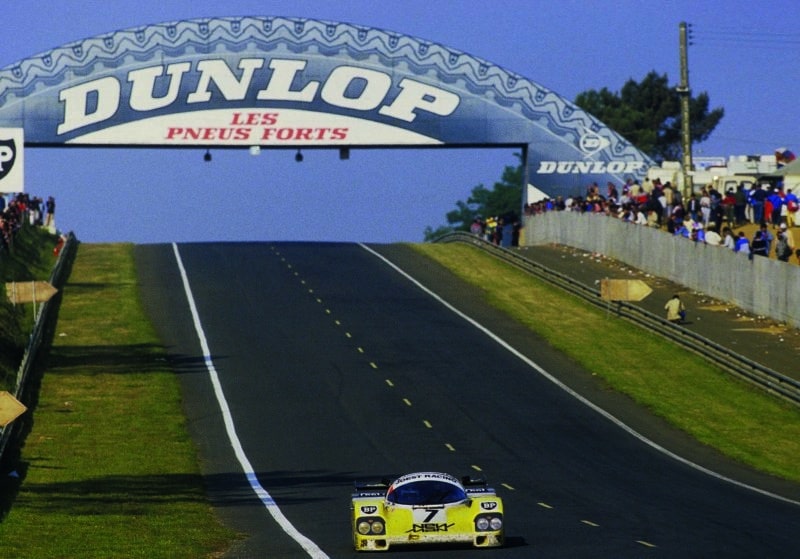
Joest’s Newman-sponsored 956 was a controversial winner in 1985 – but it outclassed the works team
DPPI
1985 Le Mans 24 Hours
Porsche privateer prevails
The Porsche factory had boycotted Le Mans ’84 over a swathe of proposed changes that it argued went in the face of FIA stability rules. The way was left clear for the marque’s privateers and Joest Racing took over the baton with its Newman-sponsored 956. Twelve months later and with the Rothmans cars back on the grid, with the long wheelbase 962 version of the 956 design, normality looked set to be restored. Only Joest, this time with Paolo Barilla and ‘John Winter’ (aka Louis Krages) joining Klaus Ludwig in the same 956 chassis that had won in ’84, did it again.
The factory could finish no better than a distant third on a day that it endured reliability issues — the third-place car driven by Bell and Hans Stuck suffered two front wheelbearing failures – and was outraced by the best of its customers. A Rothmans car failed to lead a single lap of the race! The Joest 956 was faster than the works cars, and used less fuel along the way. Exactly how Joest did it remains shrouded in mystery, as well as a controversial topic.
Reinhold Joest had been developing Porsche’s 956 concept from the moment he got his hands on one of the cars after its release to customers for the 1983 season. He built his own engines, tweaked the engine electronics, swapped from the factory-supplied Bilstein dampers to Sachs units and produced his own underfloors. Those are all facts.
Talk of special grease and gearbox oil should probably be regarded as red herrings. They resulted from a throwaway joke, insists Singer. The less-understeery handling characteristics of the 956 in comparison with the 962C was also a factor, reckons Ludwig. But rumours that Joest somehow got around the fuel restrictions at the heart of the Group C formula have never gone away. So constant were the visitors – both race officials and rival team members – to the Joest pit to look at the car’s fuel readings that the late Domingos Piedade, the squad’s team manager, placed a piece of paper over the meter on the rig. On it he drew a single finger pointing upwards. The message to those with prying eyes was clear.
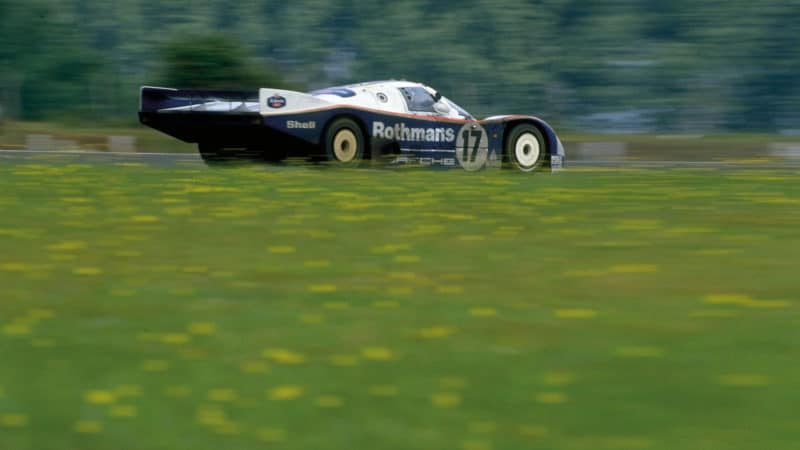
In 1987, Derek Bell made it two wins on the trot at Le Mans with the Porsche works team
Getty Images
1987 Le Mans 24 Hours
Porsche’s eggs in one basket
Porsche kept its winning sequence going at Le Mans in 1987 in what nearly turned into its annus horribilis. One of the three cars was crashed in the pre-event shakedown at Weissach, which meant the team headed to Le Mans without a spare. Another was ruled out of the race by an accident in qualifying and then a car was lost at the start of the second hour as a result of poor-quality fuel.
That left a single 962C, driven by Bell, Holbert and Stuck, to fly the flag for Porsche in the face of a concerted assault from the TWR Jaguar team on its second appearance at Le Mans. Bell, Holbert and Stuck made it six in a row for the Porsche Group C car after leading the majority of the way. But the Jaguars put them under pressure until deep into the race.
“We had a lot of bad luck and Jaguar was pretty strong that year,” says Singer, “but you only need one car to win a race.”
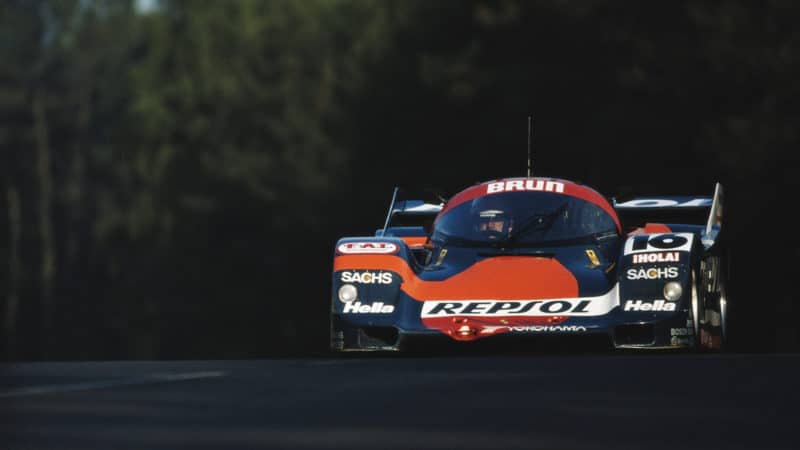
The 962C of Brun lasted more than 350 laps at Le Mans in 1990, giving the Jaguars a fright
Getty Images
1990 Le Mans 24 Hours
Old Porsche racer with new tricks
The 956/962 was the bedrock of the grid in the world championship and beyond. The factory wound down its works programme after Le Mans ’88 and left its privateers to fly the flag. It offered works assistance to old nemesis Joest from midway through ’89, but it was one of the marque’s most loyal customers that produced an amazing performance in 1990. Brun Motorsport came within 15 minutes of splitting the TWR Jags that eventually finished 1-2.
The story of how the 962C nearly got on the second step of the podium in its dotage is all the more remarkable because the star driver in the car, Oscar Larrauri, had to sit out much of the race after a major accident on Saturday morning in the support race for Renault 21 Turbos. That left team boss Walter Brun and Jesus Pareja, a pair of drivers who weren’t in the same league as the Argentinian, to do much of the donkey work.
Brun had opted to run the Repsol-sponsored 962C with a special short tail developed by the team for the new-look Circuit de la Sarthe: 1990 was the year, of course, that two chicanes were inserted into the Mulsanne Straight. The works-assisted Joest cars ran low-downforce long-tails and as a result were outpaced.
The heroic efforts of Brun and Pareja came to nought when an oil union split at the end of the Mulsanne Straight. Pareja made it around Mulsanne Corner but his 962 stopped in the old signalling pits and the driver collapsed into the arms of team members. It was a heart-rending moment.
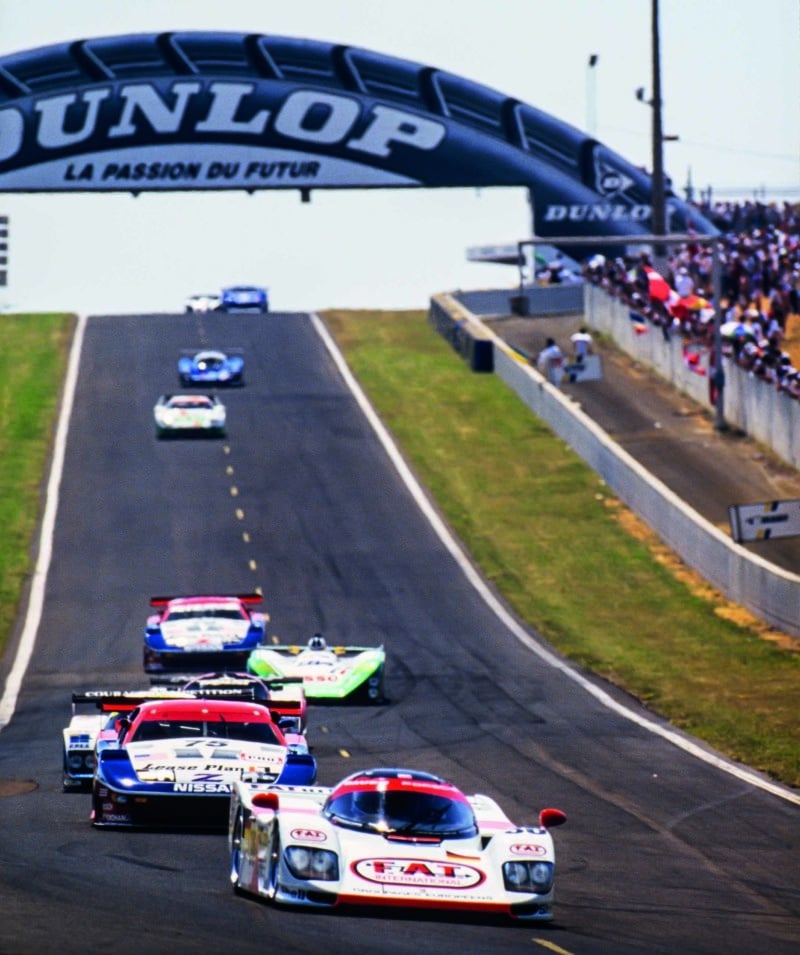
Dauer 962s came home 1-3 in 1994, 12 years after the 956 made its debut, giving Porsche its 13th win at La Sarthe (that figure is now 19)
Thierry Delaunay / DPPI
1994 Le Mans 24 Hours
Porsche 956/962 in seventh heaven
The final Le Mans win for a design a dozen years in age was based on duff information. Porsche research and development boss Horst Marchart was convinced that McLaren was going to bring the McLaren F1 to the 24 Hours in 1994 and wanted to know if the car Singer had up his sleeve could beat it to honours in the GT class, which had been re-introduced the previous year.
When Singer told his boss that the update of the 911 Turbo S LM raced in ’93 wouldn’t be up to the job, Marchart gave him a week to come up with a plan B. He opted for what could be described as plan D – D for Dauer. Sometime 962 privateer entrant Jochen Dauer had been looking for help from Porsche to get certification for his road-going version of the car, so Singer came up with the idea of a car that came to be known as the Dauer 962 LM Porsche.
The car that triumphed overall to give the 956/962 its seventh victory on the Circuit de la Sarthe shouldn’t really have been in the mix. The Group C prototypes, racing at Le Mans for the final time in modified form, were faster, though the GT machinery had an advantage on fuel capacity.
Yet Porsche claimed outright win number 13 with the car driven by Yannick Dalmas, Mauro Baldi and Hurley Haywood when the best of the Group C cars, the Toyota 90C-V entered by the Japanese SARD team, ran into gear linkage problems with 90 minutes to go. It was, however, touch and go whether the Porsche would make it cleanly to the finish. The winning car had already needed one driveshaft replacing and Singer could smell the overheating grease from the CV joints each time the car pitted.
“We kept looking at the grease on the CV joints and we decided to wait until changing the halfshaft,” recalls Singer. “Then the Toyota had its problem and we said, ‘Now we don’t even think about it.’ Mr Marchart asked what the situation was. I said I wasn’t going to tell him because then you would start to get nervous.”
